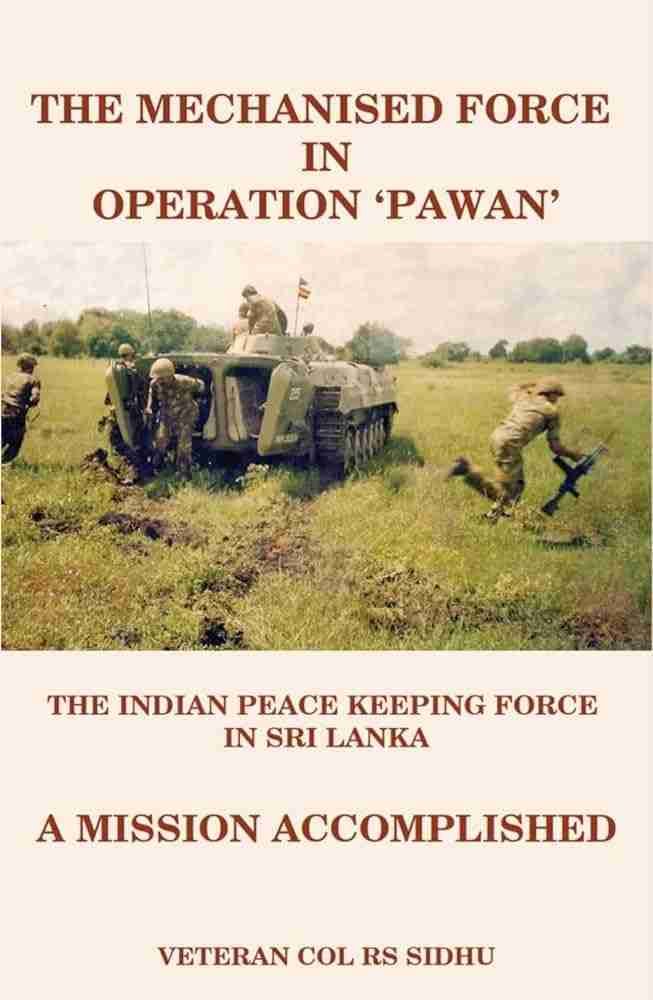The eighties were a period of great significance for the Indian Army the effects of which are still being felt.
Amongst the landmark events those of us in Service at that time went through were ; Operation Blue Star in 1984, Operation Meghdoot, the occupation of the Saltoro Ridge Line in Siachen in the same year, Exercise Brass Tacks in 1986-87 which was undoubtedly the largest military exercise conducted the scale of which has not been witnessed again, Operation Chequerboard carried out in response to the Chinese intrusion in Sumdrong Chu in Eastern Arunachal Pradesh in 1986, Operation Pawan in Sri Lanka from1987 to 1989 , Operation Cactus, to reinstate and safeguard the government in Maldives in November 1988 and combating the increase of insurgency in Kashmir Valley by 1989 resulting in the commitment of the Army in tackling insurgency there.
Colonel RS Sidhu has covered a facet of one of these. A veteran of Operation Pawan he has written an outstanding book on ‘The Mechanised Forces in Operation Pawan’. In an honest account he writes about the role they were perceived to play ie ‘a countervailing force’ but how they ended up being deployed in squads with sub unit cohesiveness broken down.
That they performed remarkably well given the constraints they had to encounter only goes to prove the mettle of the Indian soldier, the ethos of Mechanised Forces where they are able to function and carryout the assigned tasks in spite of ambiguities due to their mobility of mind to operate in a fluid battlefield environment and of course esprit de corps at the unit level the intangible sprit that ‘binds’ troops.
A Deep Look
The book written in five parts by Colonel Sidhu who was in Sri Lanka with his Battalion 15 MECHANISED INFANTRY also has contributions from other veterans.
In Part 1 of the book which is an overview, Rakesh Sidhu writes about Para 2.16 (c) of the Indo Sri Lanka Accord which pertains to India giving military assistance to Sri Lanka in case any militant group does not accept the proposals and points out that ‘there was a void in military planning for this contingency’. Later in the book he quotes General AS Kalkat, the GOC IPKF struck the nerve with his incisive remarks;” for military interventions to be successful, one of the prime considerations is to visualize the end state as a reference point for culmination of the intervention.” Bangladesh exemplifies this best, in Sri Lanka the ‘end state’ should have been end 1988 after elections for the Provincial Councils. This is probably what led to the famous signal sent by GOC IPKF in December 1988; “Mission accomplished, awaiting new orders.”
Part 2 of the book is where the author writes about the employment of the Mechanised Forces and wonders why the ab-initio grouping of these forces in a Peace keeping Operation ‘did not draw the attention of the more discerning analysts from the geopolitical community’.
At its peak 65 Armoured Regiment, 15 MECHANISED INFANTRY, 13 MECHANISED INFANTRY, a Company of 17 MECHANISED INFANTRY a Platoon of 8 MECHANISED INFANTRY and crews of 16 and 19 MECHANISED INFANTRY were deployed in Sri Lanka. They lost forty-two personnel including an officer and were awarded eleven medals including two Vir Chakras.
The Phases
He writes about the various phases of operations beginning with the Peace Keeping Operations Phase, Peace Enforcement Phase which was the focal point of mechanised operations, Establishment of a Counter Insurgency Grid in the third Phase when the focus of operations shifted to the Vanni jungles in Vavuniya Sector and the Terminal Phase which saw the orderly de-induction from the Island in spite of the challenge thrown up by the Sri Lankan Army joining hands with the LTTE during which ‘ the Mechanised Forces were tasked with maintaining a suitable deterrence posture’. It was their tactical poise along with available air effort that ensured an incident free pull out which is a lesson the US Army should have taken to avoid the chaotic manner in which they left Kabul.
The book goes into details of small team operations conducted, the innovative tactics used and of course the devastating use of IED’s by the LTTE and their deadly ambushes. What is remarkable is the manner in which these are backed by personal accounts and the rare photographs from the collection of the veterans.
The piquant situation at Palay airfield in October 1987 is well described; LTTE cadres being held in custody by the Sri Lankan Army who in turn are ringed by Indian Infantry and Para Commandos, the Sri Lankans in turn encircle these troops with Armoured Cars which were then trapped in a cordon by the BMPs of the Indian Mechanised Battalion. The consuming of cyanide by the cadre turned out to be the turning point and ‘peace keeping ‘became ‘peace enforcement’ and ‘friends turned foes’.
Part 3, remains something that is rarely written about in books, the “intangible human factor’. The subject on the impact of the deployment on the lives of the families has been sensitively handled. The most delicate and difficult task for a Commander is to deal with the families of those who laid down their lives; ‘their wailing and crying still rings loud and clear in one’s ears’.
The Human Factor
Sidhu writes about this and how the families and the unit coped with that loss. Mrs Shobha Madhavan the wife of Captain Sudhakar Madhavan of 65 Armoured Regiment, barely married for three years, they had just returned to the Regiment in Babina after a tenure in Ratnuchak near Jammu when he was ordered to move to Sri Lanka while she moved to her parents in Chennai. Within ten days her father received a call as the caller spoke in hindi he handed the phone to her. She was hopeful Sudhakar would come on the line but the caller insisted on speaking to a male relative. The mortal remains arrived the next day, she recalls following the gun carriage where sadly some passersby raised pro LTTE slogans. She has now been following that route on the same date every year for the last 34 years.
Captain Rakesh Luthra and his wife Rajni recall their wedding that was fixed and preparations made with guests arriving in Agra. There was however, no sign of the groom, the wedding was then postponed indefinitely and guests turned away including her sister being asked to detrain at from a train. Suddenly, with just a day to go, due to a postponement in operational plans he was given a few days leave from Secunderabad much to his and everyone’s surprise and the wedding took place as scheduled.
Part 4, is ‘The End State’; Operation Pawan remains the largest Tri Service military operation conducted post 1971 and many lessons abound. General VP Malik in his book; ‘India’s Military Conflicts and Diplomacy’ describes it as ‘wrong from the start’.
The author raises many issues that need to be studied at the politico – military, strategic, operational and tactical domains. There was policy confusion in the Indian security establishment in dealing with the Tamil discrimination issue’ and fault lines resulted in failure to adopt a’ coherent response to realise its strategic goals during this military intervention’. Unfortunately, the nation paid an enormous price with over 1200 Officers, JCO’s and ORs killed and over 3500 injured. Sadly, Operation Pawan has been ‘brushed under the carpet’.
As the author writes; ‘For Indian diplomacy to be relevant in the volatile geo political environment of the coming decade, a well equipped and trained military force for executing combat military intervention in near abroad is vital’.
Special Touch
The autographed philatelic collection belonging to Sammir Shakare a Scientist with ISRO in Ahmedabad is covered in Part 5. He is an avid philatelist and his father Major Sardar Shakare was in the Army Postal Service and is an IPKF Veteran. The collection covers a large number of units and has immense historical value.
The presence of about a Brigade strength of Mechanised Forces including one Armoured Regiment along with the four Divisions has been underplayed. Normally, Mechanised troops have not been deployed in combating insurgencies in India and the thirty-two-month deployment threw up many valuable lessons which are relevant even today.
Though employed beyond their designed roles by being deployed in sub units and even squads over extended frontages in varied terrain ranging from dense built-up areas to thick jungles, boggy marshlands, large lagoons and sandy beaches they came out with flying colours which speaks volumes of the Indian Army combat skills.
Operation Pawan will no doubt go down as a unique operation a truly volatile, uncertain, complex and ambiguous (VUCA) military situation which thew up the highest leadership challenges. Planned as a conventional amphibious and air transported military operation against the Sri Lankan military it got executed as a Peace Keeping Operation which soon turned to Peace Enforcement and unconventional operations against the LTTE.
This book is an important contribution in understanding some of its important facets of it and has appeal beyond readers interested in military history and warfare.


